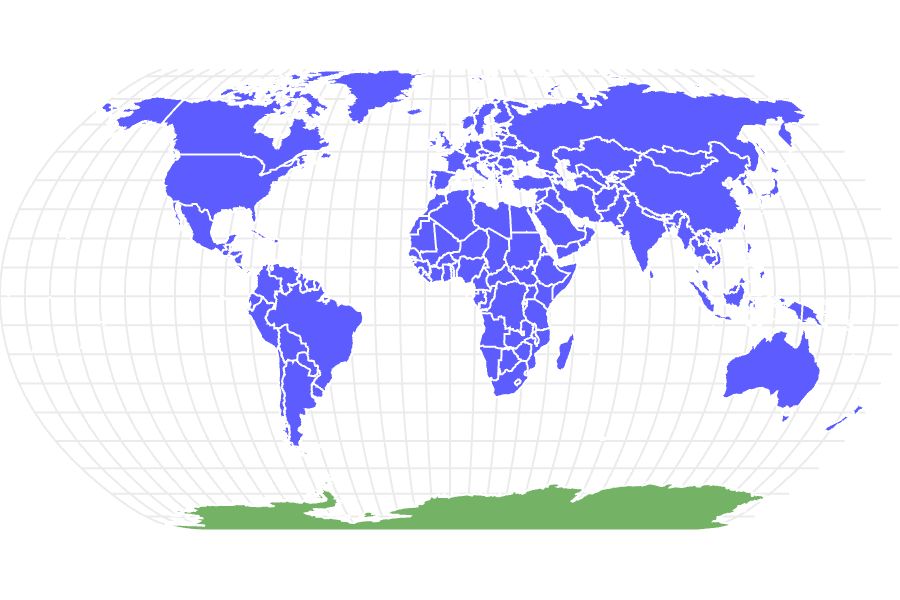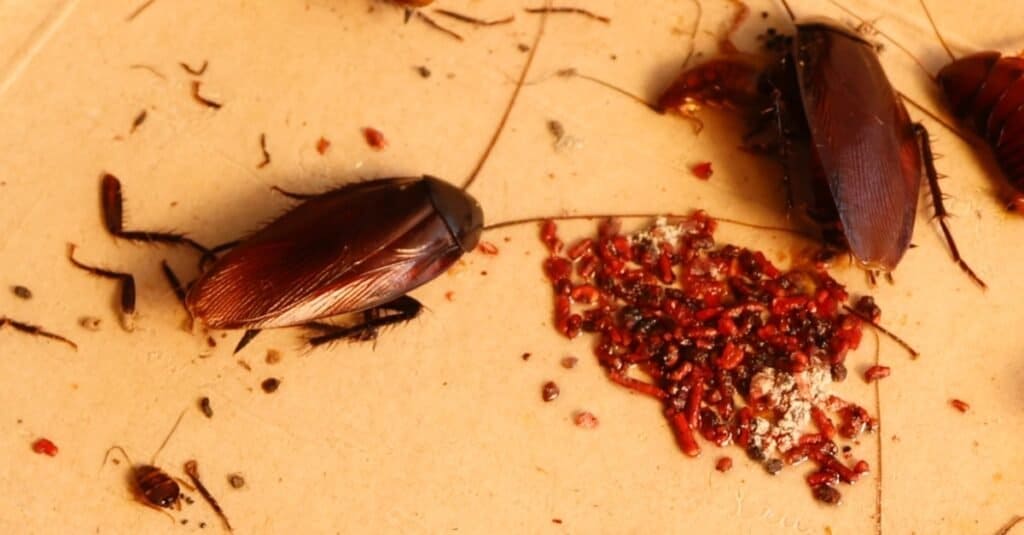Smokybrown Cockroach
Periplaneta fuliginosa
Has up to 45 eggs per egg case
Advertisement
Smokybrown Cockroach Scientific Classification
- Kingdom
- Animalia
- Phylum
- Arthropoda
- Class
- Insecta
- Order
- Blattodea
- Family
- Blattidae
- Genus
- Periplaneta
- Scientific Name
- Periplaneta fuliginosa
Read our Complete Guide to Classification of Animals.
Smokybrown Cockroach Conservation Status
Smokybrown Cockroach Locations

Smokybrown Cockroach Facts
- Prey
- Decaying plant and animal matter
- Name Of Young
- Nymph
- Group Behavior
- Colony
- Fun Fact
- Has up to 45 eggs per egg case
- Biggest Threat
- Extermination by humans
- Most Distinctive Feature
- Rich mahogany coloring
- Other Name(s)
- Roach
- Gestation Period
- 24-70 days
- Litter Size
- 40-45 eggs per egg case
- Diet
- Omnivore
- Lifestyle
- Nocturnal
- Type
- Insect
- Number Of Species
- 1
- Location
- All continents except Antarctica
View all of the Smokybrown Cockroach images!
“The smokybrown cockroach is both capable of flight and extremely susceptible to dehydration.”
Originally native to temperate parts of Southeast Asia, the smokybrown cockroach has colonized hot, humid areas all over the world. They’re particularly prevalent in parts of Japan, Asia, and the southeastern United States. Unlike other species of urban roach, who spend much of their lives indoors, the smokybrown roach actually prefers the outdoors. However, they come inside our homes and businesses just enough to create a nuisance of themselves.
Smokybrown cockroaches grow up to 1.5 inches in length; they have oval-shaped bodies and wings that stretch past their rear ends. Their antennae are very long—as long or longer than the length of their body. Like all roaches, they have six legs that come equipped with stiff spikes for gripping smooth surfaces. They’re extremely dependent on humidity, and will die if they can’t get enough moisture.
Read on to learn all there is to know about the smokybrown cockroach.
4 Incredible Smokybrown Cockroach Facts!
- Smokybrown cockroaches reproduce using egg cases called ootheca
- Both males and females have long wings that enable them to fly
- They’re originally from Asia, but have now been found on every continent except Antarctica
- Smokybrown cockroaches aren’t cold tolerant, and require warmth and humidity to survive
Smokybrown Cockroach Species, Types, and Scientific Name
The smokybrown cockroach’s scientific name is Periplaneta fuliginosa. They’re closely related to the American cockroach—more on that later. Though they originally come from Asia, smokybrown roaches now make their homes wherever there is warmth, humidity, and a source of food.
Unfortunately, smokybrown cockroaches are one of less than 50 species of roach that cause problems when they come into contact with humans. They carry disease and pathogens and can cause allergic reactions in people. If you suspect that you may have an infestation of smokybrown cockroaches, it’s important to take immediate steps to eliminate the problem.
Appearance: How to Identify Smokybrown Cockroaches
Smokybrown roaches are one of the larger species of urban cockroach. Typically, adults are between 1 ¼-1 ½ inches long. Females and males are roughly the same size, and both have body-length wings. The darkest part of the smokybrown roach is its pronotum, the hard shield that protects the top of the head. In the smokybrown cockroach, the pronotum is especially large and triangular, with rounded points.
Many roaches have wings, but that doesn’t mean they can fly. Smokybrown roaches, however, are adept flyers—but only if temperature and humidity conditions are right. Baby smokybrowns, known as nymphs, have no wings, and can’t fly.
The easiest way to tell if you’re looking at a smokybrown roach is by looking at the color and shape. Smokybrowns have dark brown, almost black heads, while the rest of their body is a rich mahogany color. Other species of roach are amber-colored or uniformly dark brown. Additionally, smokybrown cockroaches have a long, ovoid body; many other species of urban roach have rectangular bodies.

©iStock.com/Yusuke Ide
Life Cycle: How to Identify Smokybrown Cockroach Eggs
Smokybrown cockroaches reproduce via eggs encased in egg cases. The female births the egg case—which looks like a small, rectangular, brown grain of rice—and carries it with her for around 24 hours. Then, she deposits it in a safe place for the duration of incubation. Larvae emerge after 24-70 days; the duration of incubation is dependent on weather conditions.
All roaches, smokybrowns included, have three life stages: egg, nymph, and adult. Once they hatch, they’re known as nymphs. Nymphs are smaller than adults; they have no wings, but they do have six legs and two antennae. As they grow, they successively shed their ‘skin’, and regrow a larger exoskeleton. They become adult roaches when they molt their final exoskeleton. Adults no longer molt, instead, they focus on scavenging food, and making more baby roaches.
Articles Mentioning Smokybrown Cockroach
Each female smokybrown roach produces between 40 and 45 eggs per egg case. Generally, they produce around six egg cases before they die. But, not all nymphs make it to adulthood. In fact, most don’t live that long. Like other species of urban roach, the most populous smokybrown age group is actually the nymphs. This means that, if you have an infestation, it’s likely that you’ll see far more babies than adults.
Habitat: Where to Find Smokybrown Cockroach
Smokybrown roaches can be found all over the world, with one important caveat. Without moisture, they die. So, although, like many pest species of roach, they can be found wherever human settlements are found, they must have warmth and humidity to survive.
If they do happen to find a nice warm, moist place to live, you can expect to see them around the perimeters of dwellings. This is particularly true of wooded areas; smokybrown roaches love firewood, leaf litter, outdoor plants, and shrubs. Often, when they do come inside, it’s because of things like fireplaces, attics, crawl spaces, and basements, which provide them shelter from the weather. Unfortunately for the smokybrown roach though, coming inside usually means a quick death from dehydration.
Diet: What do Smokybrown Cockroaches Eat?
Smokybrown cockroaches are omnivores; specifically, they’re detritivores. This means that they eat detritus of all kinds. Typical foods in their diet include: rotting leaves and vegetation, human and animal waste, leftover food, bird waste, and decomposing animal matter. The smokybrown feeds primarily on plant waste like leaf litter and dying plants.
What Eats the Smokybrown Cockroach?
Smokybrown cockroaches have no form of defense against predators, that’s why they’re mostly nocturnal—most predators come out in the daytime. This night-owl behavior does leave them exposed to other creatures though, like mice, rats, and owls, that have no problem eating a midnight snack.
Though we’ve all heard of people eating cockroaches (maybe you’ve even tried one yourself), smokybrown roaches are not the right choice for cuisine. Only cockroaches that have been bred and raised in sterile conditions specifically for eating should be consumed. Never attempt to eat a smokybrown cockroach; they carry disease and are often plagued by internal nematodes.
Smokybrown Roach vs. American Roach: How to Tell the Difference
Out of all the roaches in the world (nearly 5,000 unique species) the American Cockroach is the one most commonly confused for the smokybrown roach. If you’re wondering which type you’re looking at, take a look at the pronotum (the shield covering the roach’s head).
In American cockroaches, the pronotum is amber-colored, with two dark brown spots. In contrast, the smokybrown roach’s pronotum is very dark brown, with no discerning markings. Additionally, American cockroaches have a narrower, more rectangular body than smokybrown roaches, which have more ovoid bodies.
Prevention and Extermination: How to Get Rid of Smokybrown Cockroaches
Smokybrown cockroaches certainly aren’t the worst species of problem roach, but that doesn’t mean you want them moving in with you. Some of the earliest signs of a roach infestation include roach droppings, shed exoskeletons, egg cases, and nymphs. For smokybrown roaches, these signs often occur near fireplaces, attics, basements, and crawlspaces.
If you suspect that you have an infestation, you should either call a pest professional or purchase roach traps and insecticides immediately. Smokybrown cockroaches can cause illness and allergic reactions in humans. So, no matter how you feel about roaches, you don’t want them living with you.
View all 293 animals that start with SThank you for reading! Have some feedback for us? Contact the AZ Animals editorial team.
Sources
- University of Florida Entomology Department / Accessed February 16, 2022

















